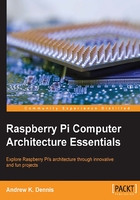
Which programming languages?
There is a plethora of programming languages available on the Raspberry Pi, so knowing where to start can be hard. Many languages are useful for a variety of different project types, including building websites, programming hardware, and writing desktop applications.
In this book we will use Assembly, C/C++, and Python. Each of these languages provides us with methods for exploring different aspects of the Raspberry Pi.
Assembly language, being so close to the computer's hardware, will help you to explore more about computer architecture and how it is realized on the Raspberry Pi. You'll also have the benefit that some of steps needed to build your executable in Assembly carry over to C and C++.
The C/C++ languages are popular for building software for controlling external electronics hardware and in the case of C, are the language Raspbian is written in. Using the knowledge you gain about Assembly, you'll be able to start tackling C programs next.
Finally, the Python programming language is incredibly versatile. From writing web servers to controlling hardware, you'll find it a useful tool for your future projects. The understanding of the C language you will gain will help to shed some light onto Python.
The first language we are going to start with is Assembly language, so login to your Raspberry Pi and get ready to write some code.